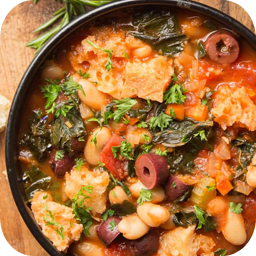Ribollita is a traditional Italian soup that originates from the Tuscany region. The name “ribollita” translates to “reboiled” in Italian, which reflects the dish’s origins as a peasant food. It was traditionally made with leftover vegetable soup, which was reheated or “reboiled” the next day. Over time, ribollita has evolved into a beloved and hearty dish known for its rich flavors and use of simple, rustic ingredients.
Key Features of Ribollita:
- Ingredients:
- Leafy Greens: The dish is made with a variety of leafy greens, most commonly kale, cavolo nero (a type of Tuscan kale), or Swiss chard. These greens are the backbone of ribollita and provide both texture and flavor.
- Beans: Cannellini beans (white beans) are typically used, adding a creamy texture and heartiness to the soup.
- Vegetables: Other vegetables such as carrots, onions, celery, potatoes, and tomatoes form the base of the soup, creating a flavorful vegetable broth.
- Bread: One of the defining characteristics of ribollita is the use of stale bread. Day-old bread (preferably unsalted Tuscan bread) is added to the soup, soaking up the liquid and contributing to the rich, thick texture of the dish.
- Olive Oil: Extra virgin olive oil is used generously in the preparation to sauté vegetables and finish the dish with a drizzle on top.
- Garlic and Herbs: Garlic and herbs like rosemary and sage are used to add depth and aromatic flavors to the soup.
- Cooking Method:
- The soup is typically made by first sautéing onions, carrots, celery, and garlic in olive oil until softened. Then, potatoes, beans, and tomatoes are added along with water or broth, creating a vegetable soup base.
- Once the soup has simmered and the flavors have melded, stale bread is added to thicken the soup and absorb the liquid. The bread breaks down, enriching the texture of the soup.
- The soup is traditionally allowed to sit and rest for a few hours or even overnight to allow the flavors to develop.
- Before serving, the soup is “reboiled” (or reheated), which is where it gets its name. It is often finished with a generous drizzle of olive oil and served hot.
- Serving:
- Ribollita is served as a main dish, often accompanied by crusty bread.
- It is commonly enjoyed with a drizzle of extra virgin olive oil and sometimes a sprinkle of Parmesan cheese.
Cultural Significance:
- Peasant Dish: Ribollita originated as a peasant dish in Tuscany, made from leftover vegetables, beans, and stale bread. It was a practical way to use up ingredients and avoid waste.
- Seasonal Dish: It is a winter dish, as it is made with hearty vegetables that are available in cooler months, particularly kale and cabbage.
- Comfort Food: Ribollita is beloved as comfort food in Tuscany and beyond, offering warmth and satisfaction on cold days.
Serving Suggestions:
- With a Drizzle of Olive Oil: Serve ribollita with a generous drizzle of extra virgin olive oil for extra flavor.
- Cheese Garnish: While traditional ribollita is served without cheese, some people like to top it with grated Parmesan.
- Pair with Wine: A medium-bodied red wine, such as Chianti, pairs wonderfully with ribollita to complement its rich, earthy flavors.

